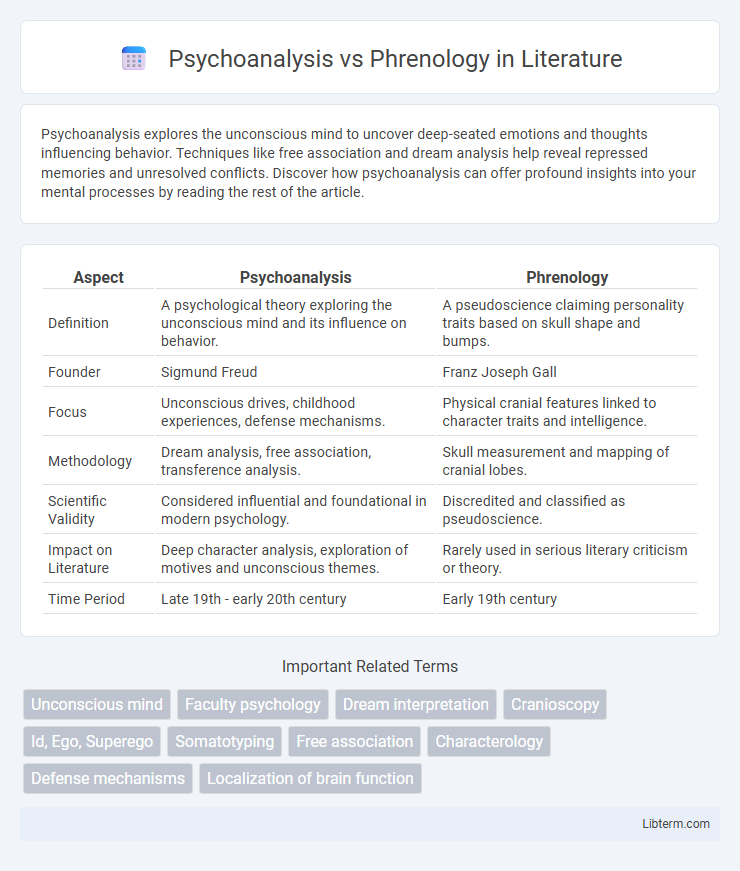Psychoanalysis explores the unconscious mind to uncover deep-seated emotions and thoughts influencing behavior. Techniques like free association and dream analysis help reveal repressed memories and unresolved conflicts. Discover how psychoanalysis can offer profound insights into your mental processes by reading the rest of the article.
Table of Comparison
| Aspect | Psychoanalysis | Phrenology |
|---|---|---|
| Definition | A psychological theory exploring the unconscious mind and its influence on behavior. | A pseudoscience claiming personality traits based on skull shape and bumps. |
| Founder | Sigmund Freud | Franz Joseph Gall |
| Focus | Unconscious drives, childhood experiences, defense mechanisms. | Physical cranial features linked to character traits and intelligence. |
| Methodology | Dream analysis, free association, transference analysis. | Skull measurement and mapping of cranial lobes. |
| Scientific Validity | Considered influential and foundational in modern psychology. | Discredited and classified as pseudoscience. |
| Impact on Literature | Deep character analysis, exploration of motives and unconscious themes. | Rarely used in serious literary criticism or theory. |
| Time Period | Late 19th - early 20th century | Early 19th century |
Introduction to Psychoanalysis and Phrenology
Psychoanalysis, developed by Sigmund Freud in the late 19th century, focuses on understanding unconscious motivations, desires, and conflicts influencing human behavior. Phrenology, a pseudoscientific theory popular in the 19th century, claimed that personality traits and mental abilities could be determined by the shape and bumps of the skull. While psychoanalysis laid the foundation for modern psychology by exploring the unconscious mind, phrenology has been discredited due to its lack of empirical evidence and scientific validity.
Historical Backgrounds: Origins and Founders
Psychoanalysis originated in the late 19th century, founded by Sigmund Freud, who emphasized the unconscious mind's influence on behavior and developed techniques like free association and dream analysis. Phrenology emerged earlier, in the early 19th century, pioneered by Franz Joseph Gall, who proposed that personality traits and mental faculties could be determined by the shape of the skull. While phrenology was quickly discredited as pseudoscience, psychoanalysis laid the groundwork for modern psychology and psychotherapy.
Core Principles of Psychoanalysis
Psychoanalysis centers on exploring unconscious motivations and early childhood experiences to understand human behavior, emphasizing concepts such as the id, ego, and superego. This therapeutic approach uses techniques like free association and dream analysis to uncover repressed emotions and conflicts. In contrast, phrenology is a debunked theory that attempted to correlate skull shape with personality traits, lacking empirical support and scientific validity.
Fundamental Beliefs of Phrenology
Phrenology is based on the belief that the brain is the organ of the mind, with specific mental faculties and character traits localized in distinct areas of the cerebral cortex. Practitioners assert that variations in the shape and size of the skull reflect underlying brain development, thereby indicating an individual's personality and cognitive abilities. This pseudoscientific approach contrasts sharply with psychoanalysis, which emphasizes unconscious motivations and psychological processes rather than anatomical features.
Methods and Techniques
Psychoanalysis employs techniques such as free association, dream interpretation, and transference analysis to uncover unconscious conflicts and desires influencing behavior. Phrenology relies on the measurement and examination of skull contours, asserting that mental faculties and personality traits correspond to specific brain areas reflected in skull shape. While psychoanalysis explores the mind through verbal and symbolic analysis, phrenology focuses on physical cranial features to infer psychological characteristics.
Scientific Reception and Criticism
Psychoanalysis, founded by Sigmund Freud, gained significant influence in psychology despite ongoing debates regarding its scientific validity and empirical support. Phrenology, developed in the 19th century by Franz Joseph Gall, was widely discredited by the scientific community due to its lack of empirical evidence and methodological flaws. Modern neuroscience and psychology have firmly rejected phrenology, while psychoanalysis continues to be critiqued for its theoretical assumptions and limited falsifiability.
Key Figures and Their Contributions
Sigmund Freud, the pioneer of psychoanalysis, introduced groundbreaking concepts such as the unconscious mind, defense mechanisms, and the significance of childhood experiences in shaping personality. Franz Joseph Gall, the founder of phrenology, proposed that specific mental faculties and character traits could be identified by examining the shape and bumps of the skull, influencing early neuroscience despite its lack of scientific validity. Freud's psychoanalysis laid the foundation for modern psychotherapy, while Gall's phrenology contributed to early efforts to localize brain functions.
Influence on Modern Psychology
Psychoanalysis, founded by Sigmund Freud, profoundly shaped modern psychology by introducing concepts such as the unconscious mind, defense mechanisms, and the importance of early childhood experiences. Phrenology, once popular in the 19th century, influenced the development of neuroscience despite being scientifically discredited due to its unfounded claims linking skull morphology to personality traits. The legacy of psychoanalysis persists in contemporary psychotherapy and clinical practice, while phrenology's impact remains primarily historical and cautionary.
Legacy and Cultural Impact
Psychoanalysis, founded by Sigmund Freud, revolutionized modern psychology by introducing concepts like the unconscious mind and defense mechanisms, significantly influencing literature, art, and therapy practices worldwide. In contrast, phrenology, once popular in the 19th century for linking skull shapes to personality traits, was discredited as pseudoscience but left a lasting impact on early criminology and anthropology debates. Both have shaped cultural perceptions of human behavior, with psychoanalysis maintaining enduring academic and clinical relevance while phrenology serves as a historical lesson in scientific rigor.
Conclusion: Comparing Psychoanalysis and Phrenology
Psychoanalysis, founded by Sigmund Freud, emphasizes the exploration of unconscious motives and early childhood experiences in understanding human behavior, using techniques like free association and dream analysis. Phrenology, a 19th-century pseudoscience, claims personality traits and mental faculties can be determined by the shape of the skull, lacking empirical support and scientific validity. Modern psychology recognizes psychoanalysis as a foundational theory for personality and mental disorders, while dismissing phrenology as obsolete and scientifically invalid.
Psychoanalysis Infographic

 libterm.com
libterm.com